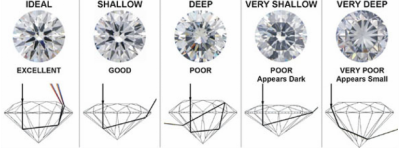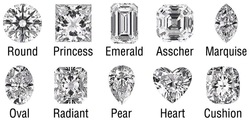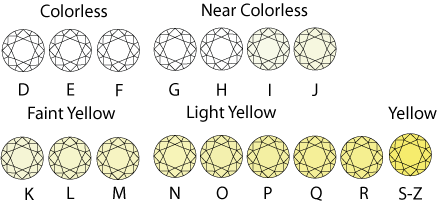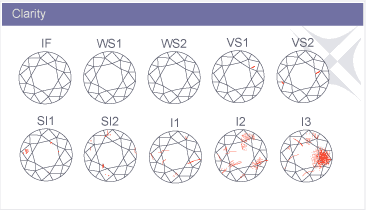Diamonds

Cut:
The cut of a diamond — its roundness, its depth and width, the uniformity of the facets — all determine a diamond's brilliance. Many gemologists consider cut the most important diamond characteristic because even if a diamond has perfect color and clarity, a diamond with a poor cut will have dulled brilliance. The width and depth have the greatest effect on how light travels within the diamond, and how it exits in the form of brilliance.
Too Shallow: Light is lost out the bottom causing the diamond to lose brilliance.
Too Deep: Light escapes out the sides causing the diamond to appear dark and dull.
Polish and Symmetry also affect sparkle: Polish and symmetry are two important aspects of the cutting process. The polish grade describes the smoothness of the diamond's facets, and the symmetry grade refers to alignment of the facets. With poor polish, the surface of a facet can be dulled,and may create blurred or dulled sparkle. With poor symmetry, light can be misdirected as it enters and exits the diamond. The polish and symmetry grades are clearly listed in each diamond detail page and within the diamond grading report. For the most beautiful diamond, look for a symmetry grade of ideal (ID),excellent (EX), very good (VG), or good (G) Avoid diamonds with symmetry grades of fair (F) or poor (P), as the alignment of their facets may misdirect light so severely that it affects the brilliance of the diamond.
Color:
Acting as a prism, a diamond can divide light into a spectrum of colors and reflect this light as colorful flashes called fire. Just as when looking through colored glass, color in a diamond will act as a filter, and will diminish the spectrum of color emitted. The less color in a diamond, the more colorful the fire, and the better the color grade.
D: Absolutely colorless. The highest color grade, which is extremely rare.
E: Colorless. Only minute traces of color can be detected. A rare diamond.
F: Colorless. Slight color detected by an expert, but still considered a "colorless" grade. A high-quality diamond.
G-H: Near-colorless. Color noticeable when compared to diamonds of better grades, but these grades offer excellent value.
I-J: Near-colorless. Color noticeable when compared to diamonds of better grades. An excellent value.
K-Z: Not reccommended by The Jeweler's Studio
Note: The Jeweler's Studio also carries fancy yellow diamonds (and any other colored diamond, green, blue, pink, purle red, etc.) These diamonds are graded on a different color scale than white diamonds. Since the scale above ranges from the best to the worst quality in a white diamond, the yellow color in fancy-yellow diamonds cannot be found on this scale.
A note about Flourescence:
Some people seek diamonds that produce this unique effect, while others definitely avoid it. The visible effects of fluorescence grades of faint, inert, negligible, and medium, can only be detected by a trained gemologist. A fluorescence grade of strong or very strong can make a diamond with a near-colorless grade look even whiter yet in some instances give the diamond a slight hazy or oily appearance. Diamonds with a strong or very strong fluorescence are priced slightly lower than other diamonds.
Clarity:
FL, IF Diamonds: Flawless: No internal or external flaws. Internally Flawless: No internal flaws. Very rare and beautiful diamonds.
VVS1, VVS2 Diamonds: Very, Very Slightly Included: Very difficult to see inclusions under 10x magnification.
VS1, VS2 Diamonds: Very Slightly Included: Inclusions are not visible to the unaided eye. Less expensive than the VVS1 or VVS2 grades.
SI1, SI2 Diamonds: Slightly Included: Inclusions are visible under 10x magnification, and difficult to see inclusions with the unaided eye. A great diamond value.
I1 Diamonds: Included: Able to see with unaided eye, but possible to get a nice, almost "eye clean" stone.The correct I1 stones can sometimes make a great value.
I2, I3 Diamonds: Very included
Carat Weight:
When diamonds are mined, large gems are discovered much less frequently than small ones, which makes large diamonds much more valuable. In fact, diamond prices rise
exponentially with carat weight. So, a 2-carat diamond of a given quality is always worth more than two 1-carat diamonds of the same quality.
The cut of a diamond — its roundness, its depth and width, the uniformity of the facets — all determine a diamond's brilliance. Many gemologists consider cut the most important diamond characteristic because even if a diamond has perfect color and clarity, a diamond with a poor cut will have dulled brilliance. The width and depth have the greatest effect on how light travels within the diamond, and how it exits in the form of brilliance.
Too Shallow: Light is lost out the bottom causing the diamond to lose brilliance.
Too Deep: Light escapes out the sides causing the diamond to appear dark and dull.
Polish and Symmetry also affect sparkle: Polish and symmetry are two important aspects of the cutting process. The polish grade describes the smoothness of the diamond's facets, and the symmetry grade refers to alignment of the facets. With poor polish, the surface of a facet can be dulled,and may create blurred or dulled sparkle. With poor symmetry, light can be misdirected as it enters and exits the diamond. The polish and symmetry grades are clearly listed in each diamond detail page and within the diamond grading report. For the most beautiful diamond, look for a symmetry grade of ideal (ID),excellent (EX), very good (VG), or good (G) Avoid diamonds with symmetry grades of fair (F) or poor (P), as the alignment of their facets may misdirect light so severely that it affects the brilliance of the diamond.
Color:
Acting as a prism, a diamond can divide light into a spectrum of colors and reflect this light as colorful flashes called fire. Just as when looking through colored glass, color in a diamond will act as a filter, and will diminish the spectrum of color emitted. The less color in a diamond, the more colorful the fire, and the better the color grade.
D: Absolutely colorless. The highest color grade, which is extremely rare.
E: Colorless. Only minute traces of color can be detected. A rare diamond.
F: Colorless. Slight color detected by an expert, but still considered a "colorless" grade. A high-quality diamond.
G-H: Near-colorless. Color noticeable when compared to diamonds of better grades, but these grades offer excellent value.
I-J: Near-colorless. Color noticeable when compared to diamonds of better grades. An excellent value.
K-Z: Not reccommended by The Jeweler's Studio
Note: The Jeweler's Studio also carries fancy yellow diamonds (and any other colored diamond, green, blue, pink, purle red, etc.) These diamonds are graded on a different color scale than white diamonds. Since the scale above ranges from the best to the worst quality in a white diamond, the yellow color in fancy-yellow diamonds cannot be found on this scale.
A note about Flourescence:
Some people seek diamonds that produce this unique effect, while others definitely avoid it. The visible effects of fluorescence grades of faint, inert, negligible, and medium, can only be detected by a trained gemologist. A fluorescence grade of strong or very strong can make a diamond with a near-colorless grade look even whiter yet in some instances give the diamond a slight hazy or oily appearance. Diamonds with a strong or very strong fluorescence are priced slightly lower than other diamonds.
Clarity:
FL, IF Diamonds: Flawless: No internal or external flaws. Internally Flawless: No internal flaws. Very rare and beautiful diamonds.
VVS1, VVS2 Diamonds: Very, Very Slightly Included: Very difficult to see inclusions under 10x magnification.
VS1, VS2 Diamonds: Very Slightly Included: Inclusions are not visible to the unaided eye. Less expensive than the VVS1 or VVS2 grades.
SI1, SI2 Diamonds: Slightly Included: Inclusions are visible under 10x magnification, and difficult to see inclusions with the unaided eye. A great diamond value.
I1 Diamonds: Included: Able to see with unaided eye, but possible to get a nice, almost "eye clean" stone.The correct I1 stones can sometimes make a great value.
I2, I3 Diamonds: Very included
Carat Weight:
When diamonds are mined, large gems are discovered much less frequently than small ones, which makes large diamonds much more valuable. In fact, diamond prices rise
exponentially with carat weight. So, a 2-carat diamond of a given quality is always worth more than two 1-carat diamonds of the same quality.


